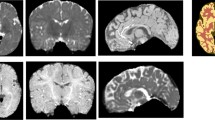Abstract
With the application of magnetic resonance imaging (MRI) in the diagnosis of brain diseases, MRI has become a powerful tool for clinical neuroimaging analysis, and whole brain segmentation is a very important step of neuroimaging analysis. In order to promote segmentation accuracy, this paper makes full use of the spatial constraint information between adjacent slice of MRI brain image sequence, and combines three consecutive images into one image named 2.5D slice image. Through 2.5D slice image, a triple U-Net-based whole brain segmentation method is proposed, which is composed of one main U-Net and two auxiliary U-Nets. Moreover, this network introduces three auxiliary outputs to provide inter-layer constraints for the final prediction, and uses a multi-auxiliary hybrid loss function based on binary cross-entropy loss and dice loss to optimize the training model. In this paper, a comprehensive comparative experiment is carried out on LPBA40 dataset and IBSR18 dataset. The experimental results show that the dice coefficient, specificity and sensitivity of this method are 98.23%, 99.62% and 98.54%, respectively, on LPBA40 dataset, and 97.01%, 99.45% and 98%, respectively, on IBSR18 dataset. The experiments show that the accuracy of whole brain segmentation is greatly improved by the proposed triple U-Net.









Similar content being viewed by others
Explore related subjects
Discover the latest articles, news and stories from top researchers in related subjects.References
Dale, A.M., Fischl, B., Sereno, M.I.: Cortical surface-based analysis I Segmentation and surface reconstruction. Neuroimage 2(9), 195 (1999)
Hahn, H.K., Peitgen, H.O.: The Skull Stripping Problem in MRI Solved by a Single 3D Watershed Transform, pp. 134–143. Springer, Berlin Heidelberg (2000)
Sandor, S., Leahy, R.: Surface-based labeling of cortical anatomy using a deformable atlas. IEEE Trans Med Imaging 16(1), 41–54 (1997)
Ségonne, F., et al.: A hybrid approach to the skull stripping problem in MRI. Neuroimage 3(22), 1060 (2004)
Shattuck, D.W., et al.: Magnetic resonance image tissue classification using a partial volume model. Neuroimage 5(13), 856 (2001)
Smith, S.M.: Fast robust automated brain extraction. 17(3), 143–155 (2002)
Ward, B.D.J.B.R.I.: Medical College of Wisconsin. Intracranial segmentation, Milwaukee, WI (1999)
Ronneberger, O., Fischer, P., Brox T.: U-Net: Convolutional networks for biomedical image segmentation. In: Navab N., Hornegger J., Wells W., Frangi A. (eds) Medical Image Computing and Computer-Assisted Intervention, pp. 234–241. Springer, Cham, Denmark (2015). https://doi.org/10.1007/978-3-319-24574-4_28
Milletari F, Navab N, and Ahmadi SA (2016) V-Net: fully convolutional neural networks for volumetric medical image segmentation. In 2016 Fourth international conference on 3D vision (3DV)
Zhang, H., et al.: Multiple sclerosis lesion segmentation with tiramisu and 2.5 d stacked slices. In: International Conference on Medical Image Computing and Computer-Assisted Intervention, pp. 338–346. Springer (2019)
Hwang, H., Lee, H.Z.R.S.: 3D U-Net for skull stripping in brain MRI. Appl Sci 9(3), 569 (2019)
Salehi, S.S., Erdogmus, D., Gholipour, A.: Auto-context convolutional neural network (Auto-Net) for brain extraction in magnetic resonance imaging. IEEE Trans Med Imaging 36(11), 2319–2330 (2017). https://doi.org/10.1109/TMI.2017.2721362
Lucena, O., Souza, R., Rittner, L., Frayne, R., Lotufo, R.: Convolutional neural networks for skull-stripping in brain MR imaging using silver standard masks. Artif Intell Med 98, 48–58 (2019)
Liang, Y., Song, W., Dym, J., Wang, K., He, L.: CompareNet: anatomical segmentation network with deep non-local label fusion. In: International Conference on Medical Image Computing and Computer-Assisted Intervention, pp. 292–300. Springer (2019)
Wen, Y., Zhang, K., Li, Z., Qiao, Y.: A discriminative feature learning approach for deep face recognition. Springer (2016)
Kim J, Kim M, Kang H, and Lee KJA (2020) U-GAT-IT: unsupervised generative attentional networks with adaptive layer-instance normalization for image-to-image translation. arXiv:1907.10830
Zhou, Z., Siddiquee, M.M.R., Tajbakhsh, N., Liang, J.: U-Net++: a nested U-Net architecture for medical image segmentation. Deep Learn Med Image Anal Multimodal Learn Clin Decis Support 2018(11045), 3–11 (2018). https://doi.org/10.1007/978-3-030-00889-5_1
Huang H, Lin L, Tong R, Hu H, Wu J (2020) U-Net 3+: a full-scale connected U-Net for medical image segmentation.In: ICASSP 2020 - 2020 IEEE International conference on acoustics, speech and signal processing (ICASSP)
Jadon, S.: A survey of loss functions for semantic segmentation. In: 2020 IEEE Conference on Computational Intelligence in Bioinformatics and Computational Biology (CIBCB), pp. 1–7. IEEE (2020)
Yi-De M, Qing L, Zhi-Bai Q (2005) Automated image segmentation using improved PCNN model based on cross-entropy. In: International symposium on intelligent multimedia
Dice, L.R.: Measures of the amount of ecologic association between species. Ecology 26(3), 297 (1945)
Shattuck, D.W., et al.: Construction of a 3D probabilistic atlas of human cortical structures. Neuroimage 39(3), 1064–1080 (2008)
Rohlfing, T.: Image similarity and tissue overlaps as surrogates for image registration accuracy: widely used but unreliable. IEEE Trans Med Imaging 31(2), 153–163 (2012)
Wong, S.C., Gatt, A., Stamatescu, V., McDonnell, M.D.: Understanding data augmentation for classification: when to warp? In: 2016 International Conference on Digital Image Computing: Techniques and Applications (DICTA), pp. 1–6. IEEE (2016)
Dosovitskiy, A., Springenberg, J.T., Riedmiller, M., Brox, T.: Discriminative Unsupervised Feature Learning with Convolutional Neural Networks. In: Advances in Neural Information Processing Systems (NIPS), vol. 27, pp. 766–774
Chang, H.H., Zhuang, A.H., Valentino, D.J., Chu, W.C.: Performance measure characterization for evaluating neuroimage segmentation algorithms. Neuroimage 47(1), 122–135 (2009)
Schell, M., et al.: Automated brain extraction of multi-sequence MRI using artificial neural networks. In: European Congress of Radiology-ECR (2019)
Acknowledgements
This work was supported by the National Natural Science Foundation of China under Grant 61162023, was supported by the Natural Science Foundation of Jiangxi Province, Grant Number 20192BAB205083.
Author information
Authors and Affiliations
Corresponding author
Ethics declarations
Conflict of interest
The authors declare that they have no conflict of interests.
Additional information
Publisher's Note
Springer Nature remains neutral with regard to jurisdictional claims in published maps and institutional affiliations.
Rights and permissions
About this article
Cite this article
Chen, X., Jiang, S., Guo, L. et al. Whole brain segmentation method from 2.5D brain MRI slice image based on Triple U-Net. Vis Comput 39, 255–266 (2023). https://doi.org/10.1007/s00371-021-02326-9
Accepted:
Published:
Issue Date:
DOI: https://doi.org/10.1007/s00371-021-02326-9




